How to Explore Roman and Modern Mérida, Spain in 2023
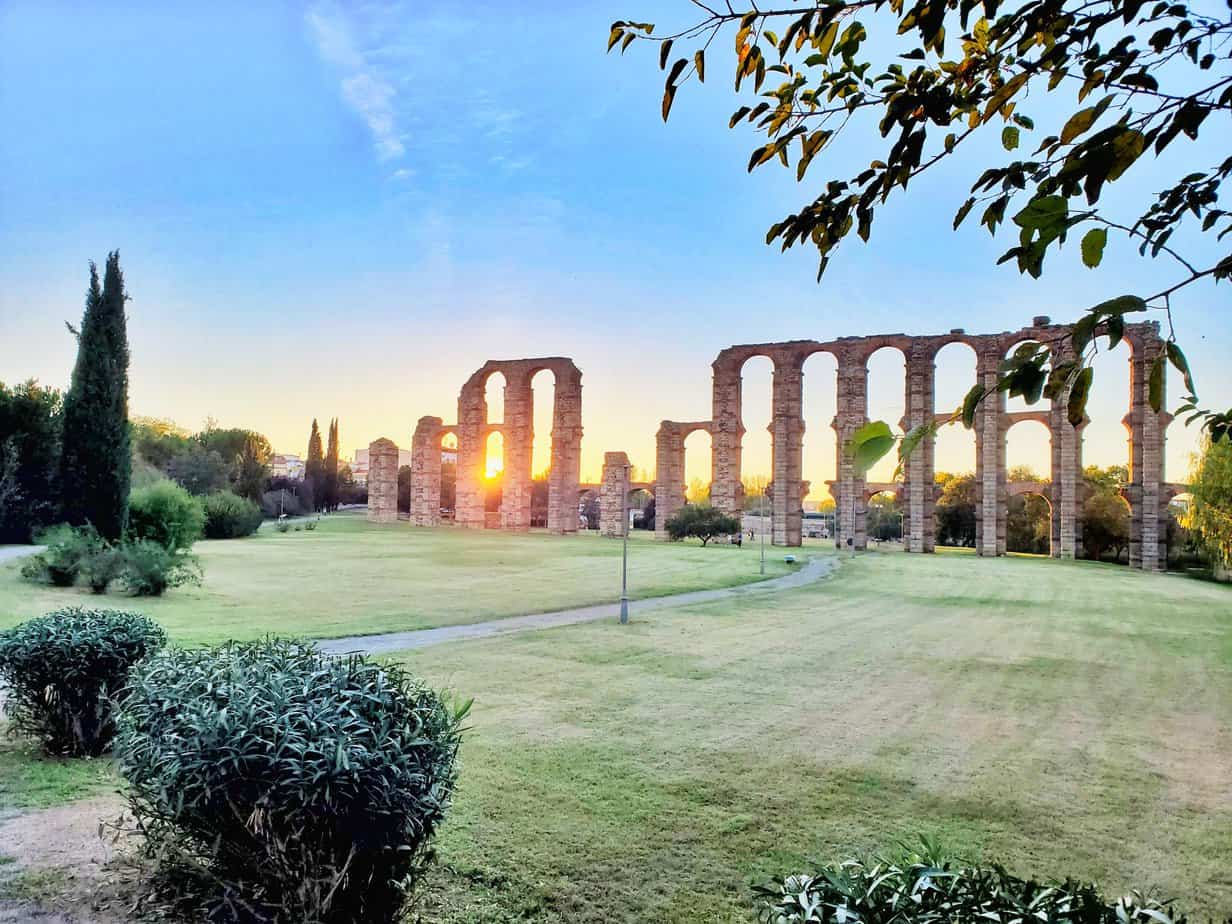
The original Mérida, the one in Spain, was founded by the Romans in the first century BCE and there’s still a surprising amount of ‘Roman Mérida’ to be seen. If you’re wondering about what to do in Mérida, let me tell you that Mérida is a perfect two or three-day destination depending on how much walking you want to do in a day and how many Roman ruins you can manage.

We spent a chilly November weekend checking out this home-from-home-Mérida (we lived in Mérida, Mexico for almost six years and that’s the city my kids consider to be their home) and found a lovely little city with a lot to recommend it.
Read on to find out what to do in Mérida, Spain.
There may be affiliate links in this article. If you click and make a purchase I may make a small sum at no extra cost to you. This is one of the ways in which I keep my blog going.
Location Highlights – why do people visit?
Mérida, as a World Heritage Site and one of the best preserved Roman sites in the whole of Spain, is a popular place to visit. The ruins here are numerous and are all beautifully restored and most information signs are in English and Portuguese as well as Spanish.
Highlights include the biggest Roman house in Europe: Casa Mitrea, the amphitheatre and the theatre and the two aqueducts, an enormous Roman bridge and more. The ruins are spread around the delightful, yet fairly compact city, leading people to wonder what remains buried under the modern city of Mérida.
Did you know that the city of Cordoba has more UNESCO World Heritgage Sites than anywhere else in the world? It’s only a three hour drive from Mérida.

Where is Mérida
Mérida is the capital of the autonomous province of Extremadura in southern Spain. It’s roughly a 2 – 2.5 hour drive from Seville.
Extremadura is home to Monfragüe National Park, one of Spain’s most wonderful national parks and one of my personal favourite places to hike in Spain.
History of Mérida
Mérida, founded in the first century BCE, with the name of Emerita Augusta, was the capital of the Roman province of Lusitania. Emperor Augustus founded it to serve as a retreat for veteran soldiers. It was apparently one of the most important cities in Roman Hispania.
After the fall of the Roman Empire, Mérida was taken over by the Visigoths and remained an important city under their rule until it was conquered by the Umayyad Caliphate. It remained under Muslim rule until it was taken by Alfonso IX of León in 1230.
The name Mérida can be traced from Emerita under the Romans to Māridah under the Muslims to the modern Mérida.
What to do in Mérida
‘My Mexican Mérida’ is full of Maya history, this Mérida is full of Roman history and ruins. We spent a full weekend checking out as much as we could.
We bought the “Entrada Conjunta” ticket for 16 Euros per adult (kids under 12 are free – huzzah). This covers entry to the sites listed below. We saw everything except the last two because in our short weekend in Mérida we simply couldn’t have fitted more in. The 16 Euros is an absolute bargain, given the individual costs of these sites (each site is 6 Euros if you pay individually except for the temple of Diana, which costs 3 Euros and the teatro & anfiteatro which is 12 Euros for the pair).
Teatro & Anfiteatro
The most visually impressive of all sites in Mérida, we spent a great deal of time here. In one site here you have both the theatre and amphitheatre – people living in Roman Mérida could decide whether to go to watch a dramatic performance or something altogether more grizzly next door.
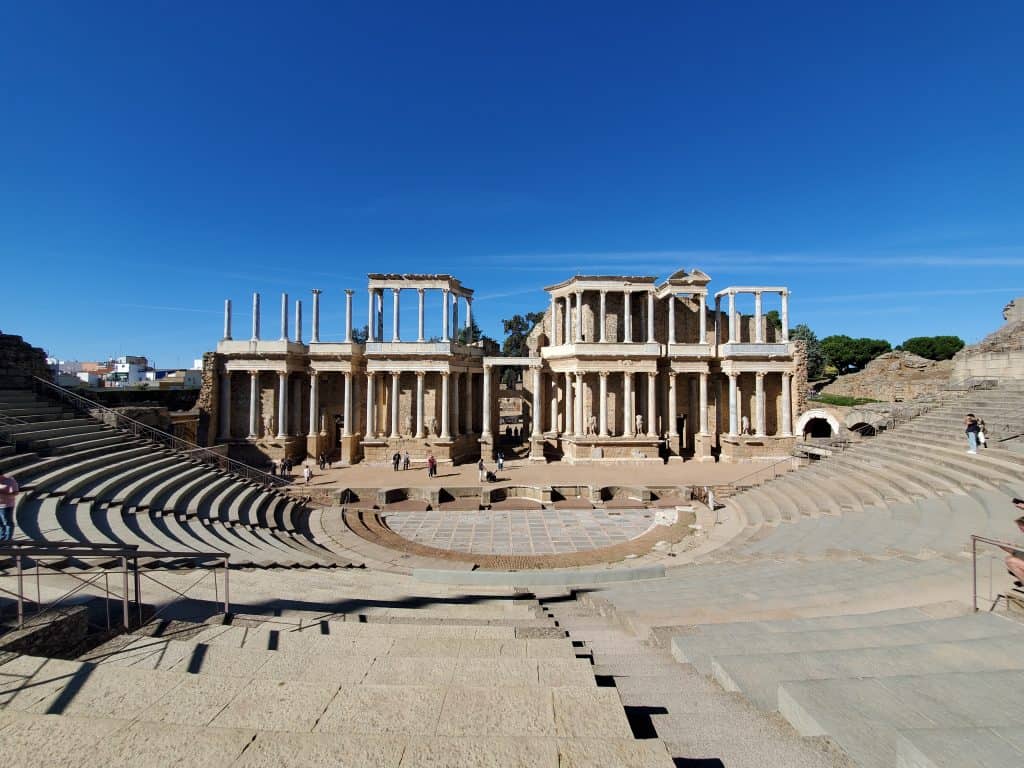
The theatre was constructed thanks to Agrippa, the son-in-law of Augustus. I learned here that the Romans weren’t super fond of theatre but still, the theatre had space for 6,000 spectators (of course, split by rank with women all the way at the back in the cheap seats, grrrrr ancient-Rome). We sat for a good while just basking in the beauty of the theatre – well, I did. The kids ran around the dark tunnels while I contemplated life and all the other things ancient history brings up). There is actually a classical theatre festival held here every year. I assume that women aren’t consigned to the shitty seats for this!
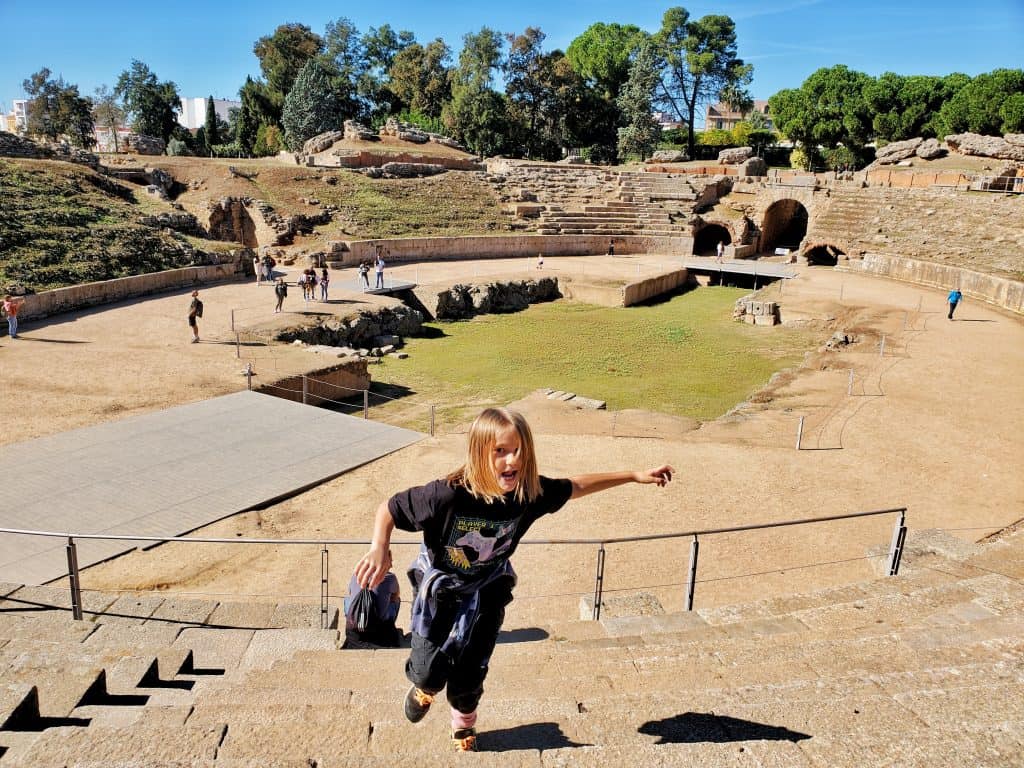
The Anfiteatro (amphitheatre), where people gathered to watch gladiators and wild animals fight was constructed around 8 BCE and could hold around 15 – 16 000 people (yup, well played Rome, more space for blood and guts than culture). The kids enjoyed a run-around here too and I saw one dad having a grand old time play sword fighting with his daughter (much to my kids’ disgust as they hadn’t been permitted to buy swords).
Alcazaba
Probably my least favourite of everything we saw, the Alcazaba is worth checking out anyway. It isn’t often you can visit an Arab citadel that also has Visigoth and Roman ruins to be seen within – what am I saying? Of course it’s fairly normal in southern Spain that you can see all three side by side. Still, it’s kinda cool. The fortress is younger than other sites in Mérida, having been built in 835 CE but it’s still the oldest Muslim fortress on the Peninsula. It was designed with three specific roles in mind: to serve as headquarters for the Umayyad administrators, as a residence for the local governor and to restrict/control access to the city via the Roman bridge and therefore provide safety to the Muslim population.
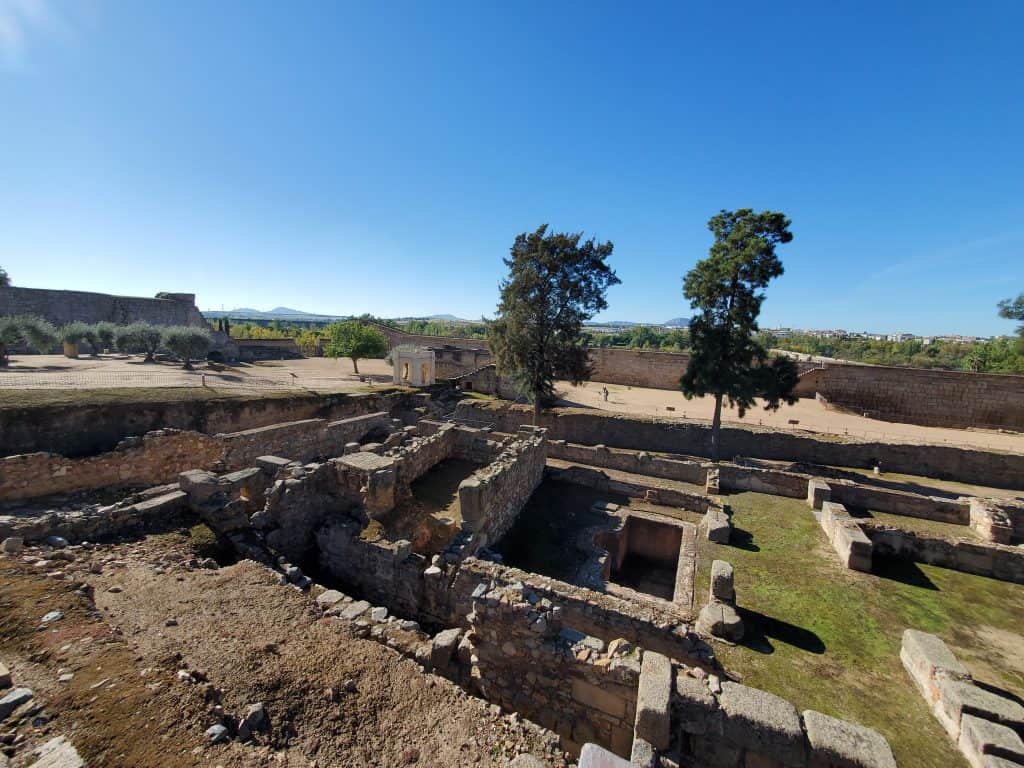
Inside, there are the remains of a Roman road, a Roman house and a fascinating underground cistern that was built reusing both Roman and Visigoth architectural pieces. There are some good signs with explanations of everything in the site.
Casa Mitreo/Mithraeum and Columbarios
This site is apparently the biggest known Roman house in Europe. It was built sometime around the end of the first century of the common era just outside the city walls. The highlight here is the first mosaic you come to, it is a representation of the cosmos revolving around the figure of Aeternitas (Eternity).

If you’re a fan of Roman ruins then you can’t miss Baelo Claudia, located on the beach near Tarifa in Andalucia or Conímbriga outside Porto, Portugal. They’re two of the best preserved Roman towns on the whole Iberian Peninsula.
Circo
Something of a walk from most other ruins is the Roman circus (be sure to prepare any kids / clown fans lest they wind up disappointed that this isn’t a modern circus). What fascinated us the most here is that it hasn’t been turned into a giant park as the setting is extremely urban and it seems a waste to have this ticketed and behind a fence. However, since it is apparently one of the best preserved circuses of the entire Roman empire, we can kind of see why it is.
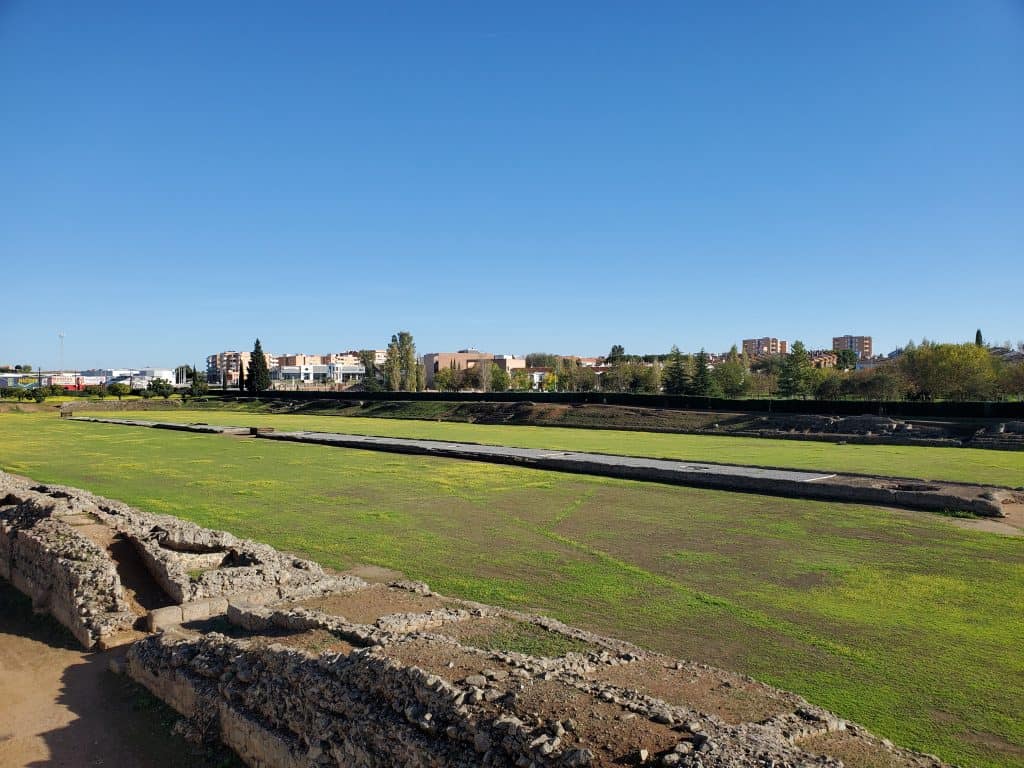
This site will have held up to 30,000 spectators (that’s half the current population of the city, by the way!).
My kids loved running around here and thought that the tiny on-site museum was cool because it had a short Asterix comic strip on the wall.
Casa Anfiteatro
Next to the theatre and amphitheatre site is Casa Anfiteatro – we almost missed out on this treat but thankfully decided to stick our heads in. The mosaics here are great and it’s set up so visitors walk just above them, even with glass floors at one section. A touch screen full of explanations was joyfully jabbed at by the kids.
⭐️ There are a myriad of excellent reasons to visit Spain, keep reading to learn more about this magnificent country ⭐️
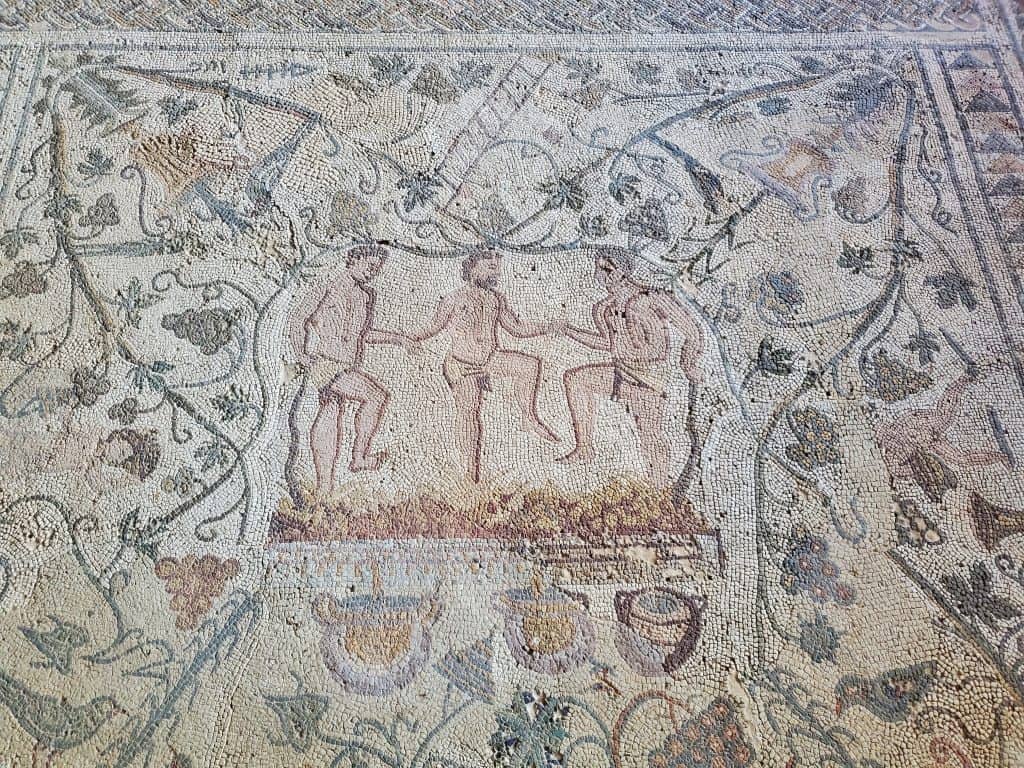
Templo de Diana
This Imperial Cult Temple is right in the middle of modern Mérida. We stopped by at around 10 pm on Saturday night when it was nicely lit up but obviously closed. We returned on Sunday morning and discovered a small museum inside the house that’s within the temple. A short video shown in the museum came as a relief to the kids who were very over Roman ruins by this point.
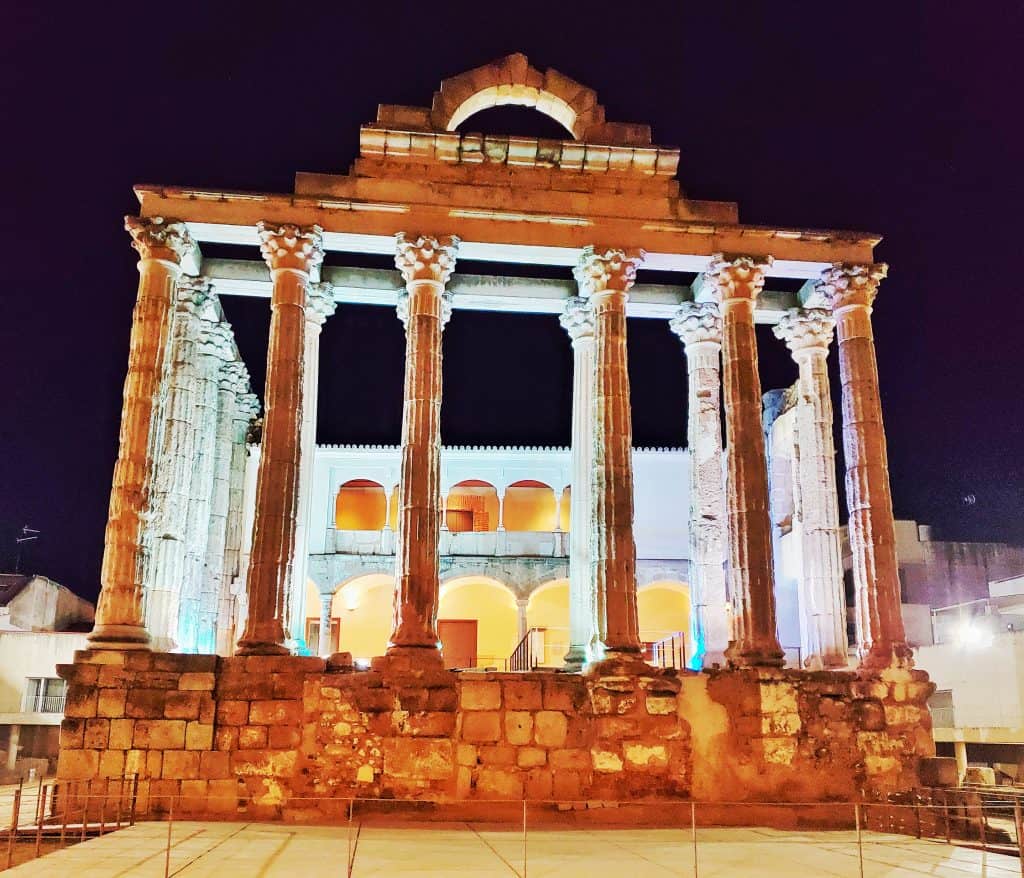
We did not see either the Cripta de la Basilica or the Zona Arqueologica Moreria due to lack of time. Both cost 6 Euros if visited as stand alone monuments but are included in the combined ticket.
What’s Free to do in Mérida?
Roman Art Museum
By the amphitheatre complex is a really very impressive museum housing enormous mosaics, artefacts and more. We particularly enjoyed the exhibition about the discovery of the Roman theatre under a chickpea field in the early twentieth century!
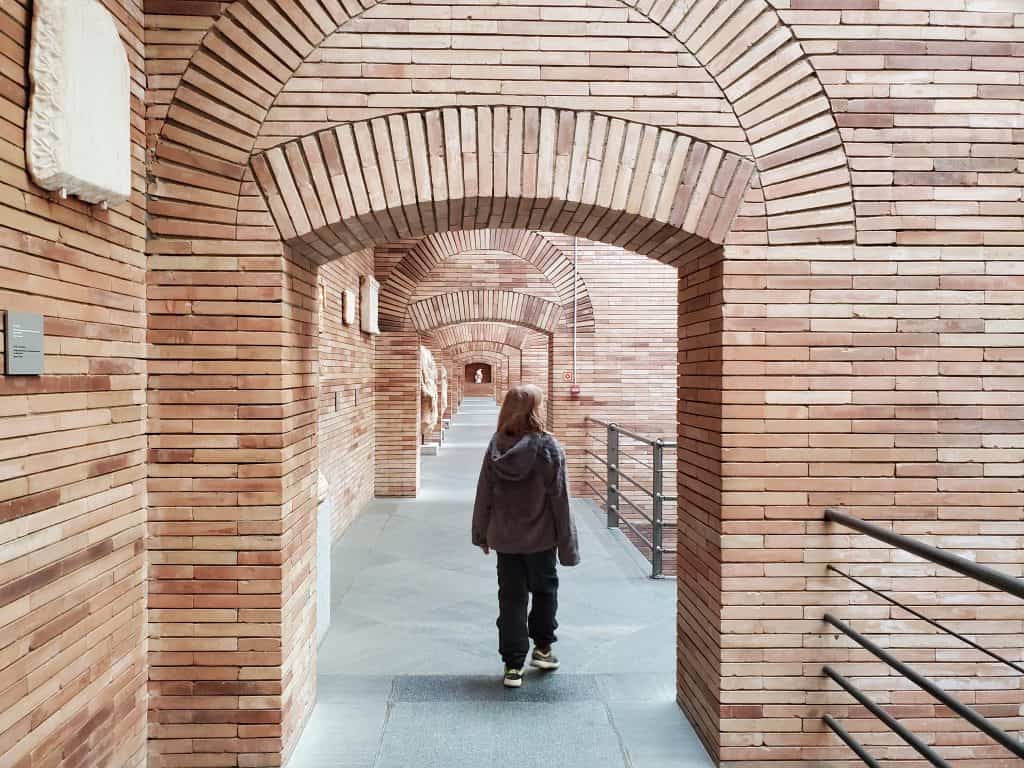
Roman Bridge
The Roman bridge over the River Guadiana is fun to walk over. If we’d had more time we’d have taken the exit in the middle down onto the island and had an explore down there. As it was, we were walking over the bridge to get to Carrefour to buy jackets for the kids because it was colder than we’d expected in early November.
The bridge is apparently one of the longest ever built by the Romans. It’s almost 800m long. If you’re a big fan of Roman ruins and Roman bridges then Cordoba is surely the next place you’ll be visiting and if you’re heading to Córdoba please don’t miss Zuheros, the gorgeous mountain village nearby.
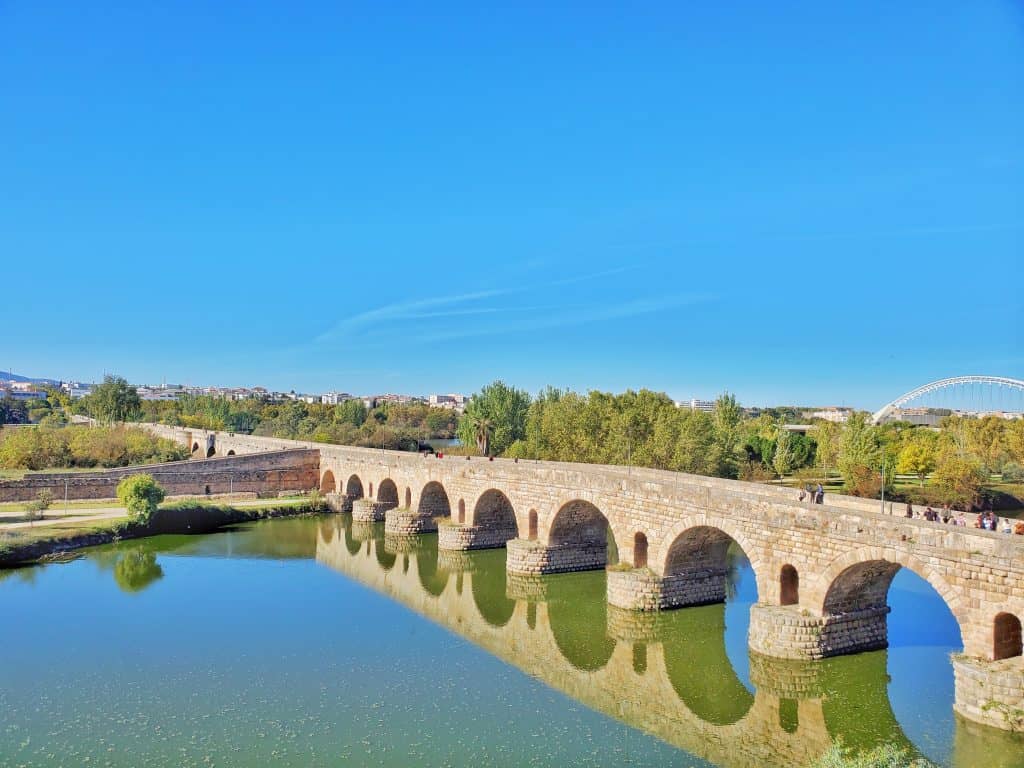
Acueducto de los Milagros
This aqueduct forms the shape of the sign for the modern city of Mérida and is really very impressive, standing at 27m tall. Apparently there is over 800 m of it too. It’s located in the park over the river and is a popular place for locals and tourists to congregate. We were there at a chilly but magnificent dusk.
Of course, the biggest aqueduct in Spain is in Segovia, which is a four-hour drive from Mérida.
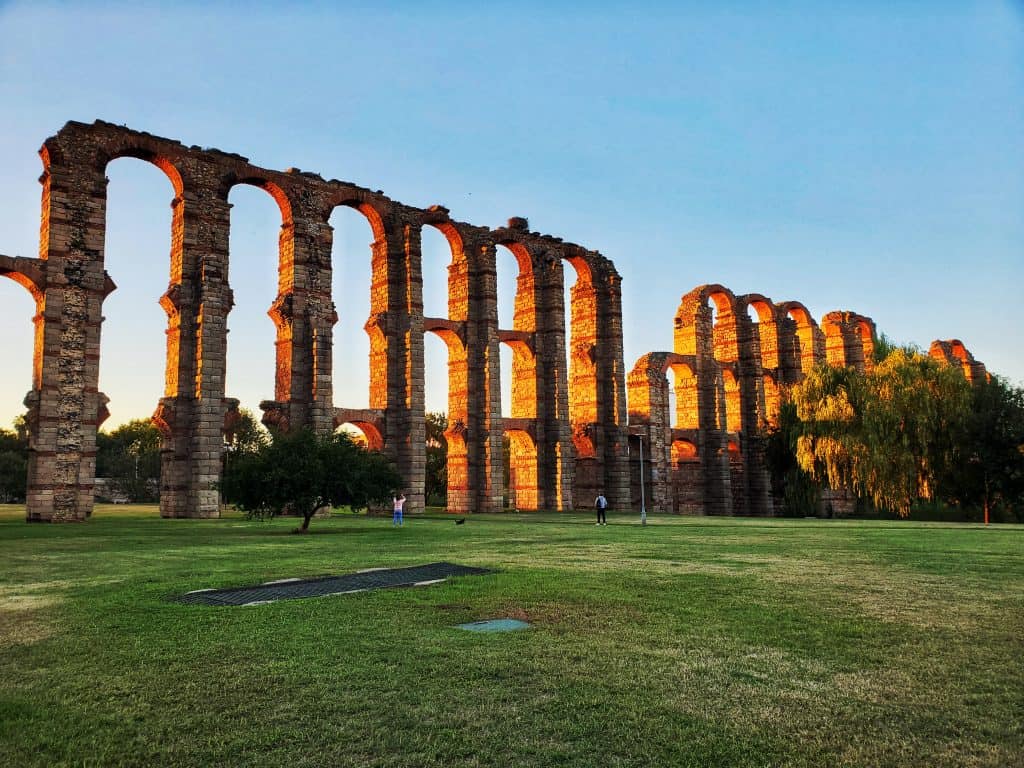
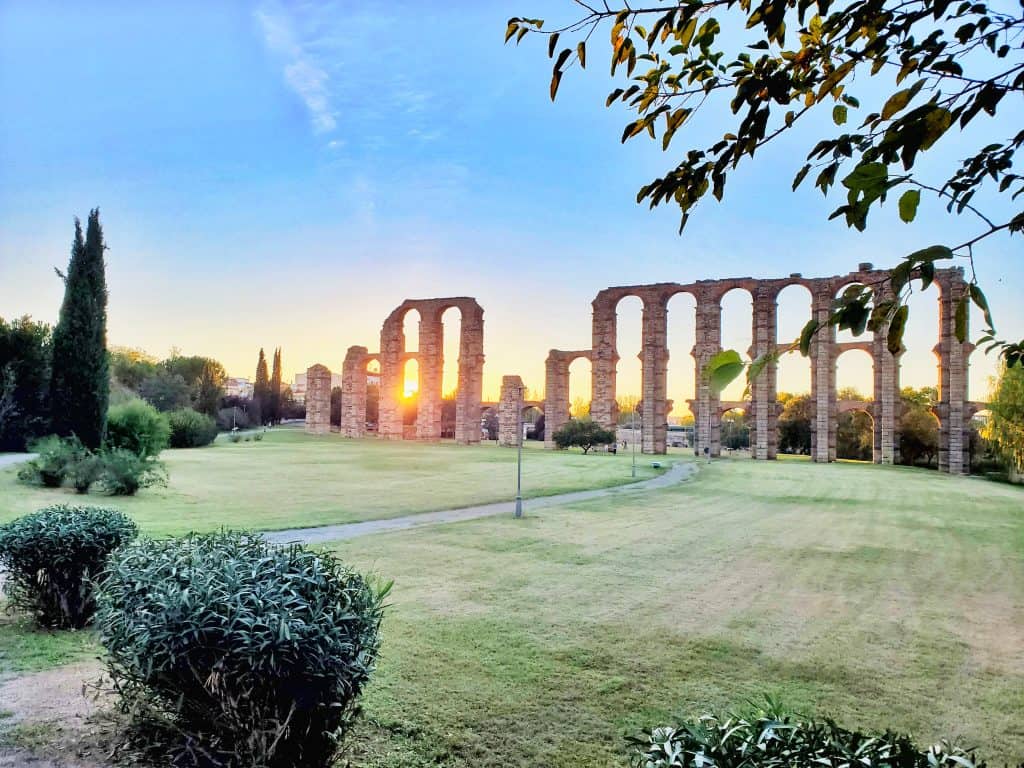
It was part of a hydraulic system bringing water to the city from the Proserpina Dam (also known as the Albuera Reservoir). Alcalá de Guadaíra, some twenty minutes outside of Seville performed this duty for Seville under the Romans: water was carried from their natural springs via aqueduct into the city. There is a little of this aqueduct visible in Sevilla to this day.
We walked here from the San Lázaro Aqueduct, which the kids enjoyed very much as it’s parkland all the way. We found three playgrounds and let them play in each of them.
Acueducto de San Lázaro
This aqueduct is about a kilometre long and was built in the first century of the common era. When we checked it out, the small river that flows under part of it was almost entirely dry so we gingerly tiptoed our way through the water – the kids thought this was hilarious.
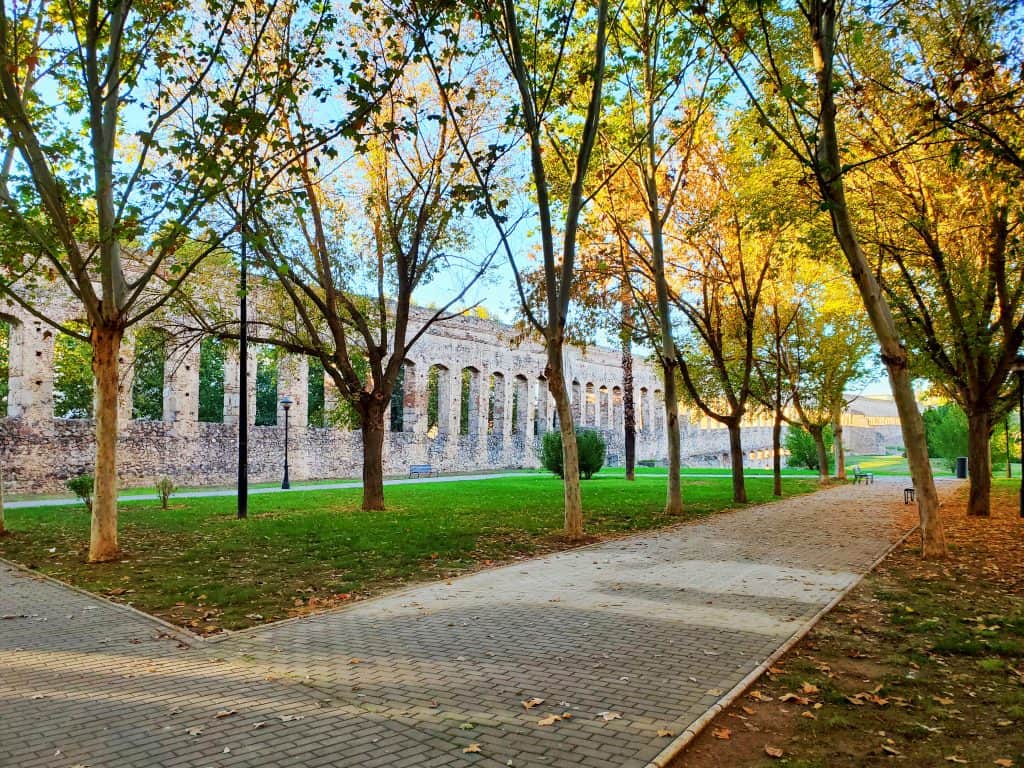
Termas de San Lázaro
Between the circus and the start of the aqueduct de San Lázaro are the remains of Roman baths.
Arco de Trajano
We ate in a restaurant right next to this arch, which was a monumental gate to a sacred space. The arch is 15m high and is pretty impressive even without the marble cladding it will have presumably had when built (we thought of this when seeing the remaining marble on an arch in the theatre complex). My favourite arches ever were part of the Ex-hacienda Santa Brigida outside Mineral de Pozos, Guanajuato, Mexico.
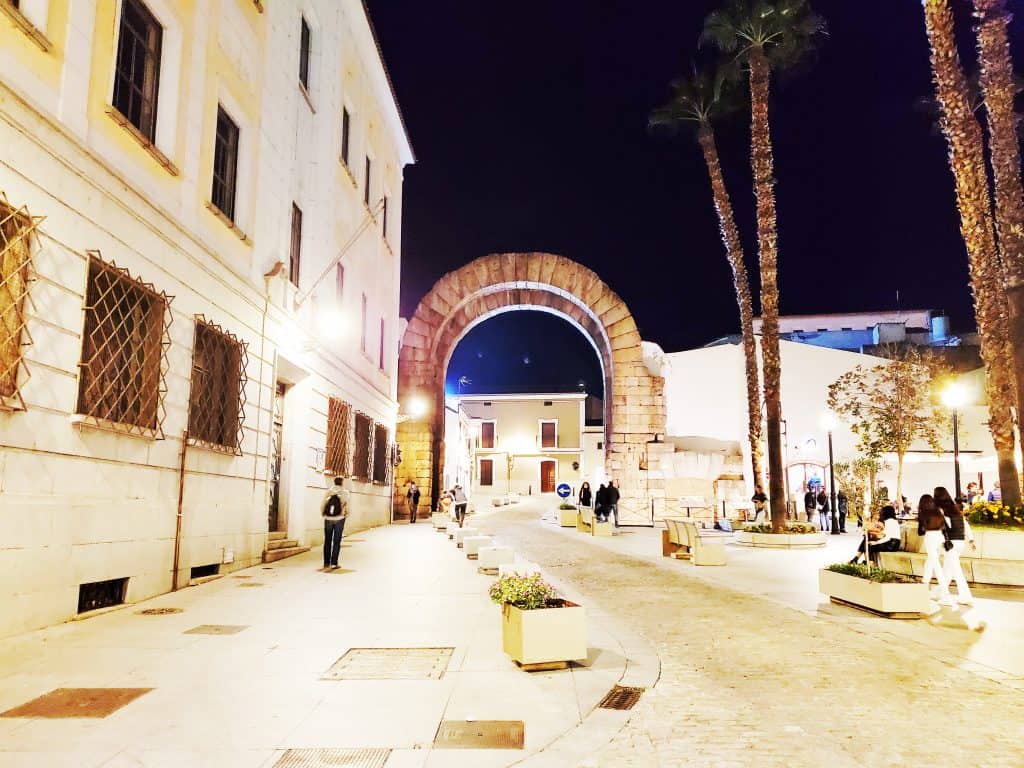
Portico de Foro Municipal de Augusta Emérita
Yet more ruins just happily sitting in the middle of the city.
Plaza de España
This lovely plaza is the centre of Mérida and we headed here when we first arrived in town. It was dusk and like any square in Spain or Mexico, was full of families enjoying the (chilly) evening. Kids were running around happily while adults were sitting in bars enjoying a drink or three.
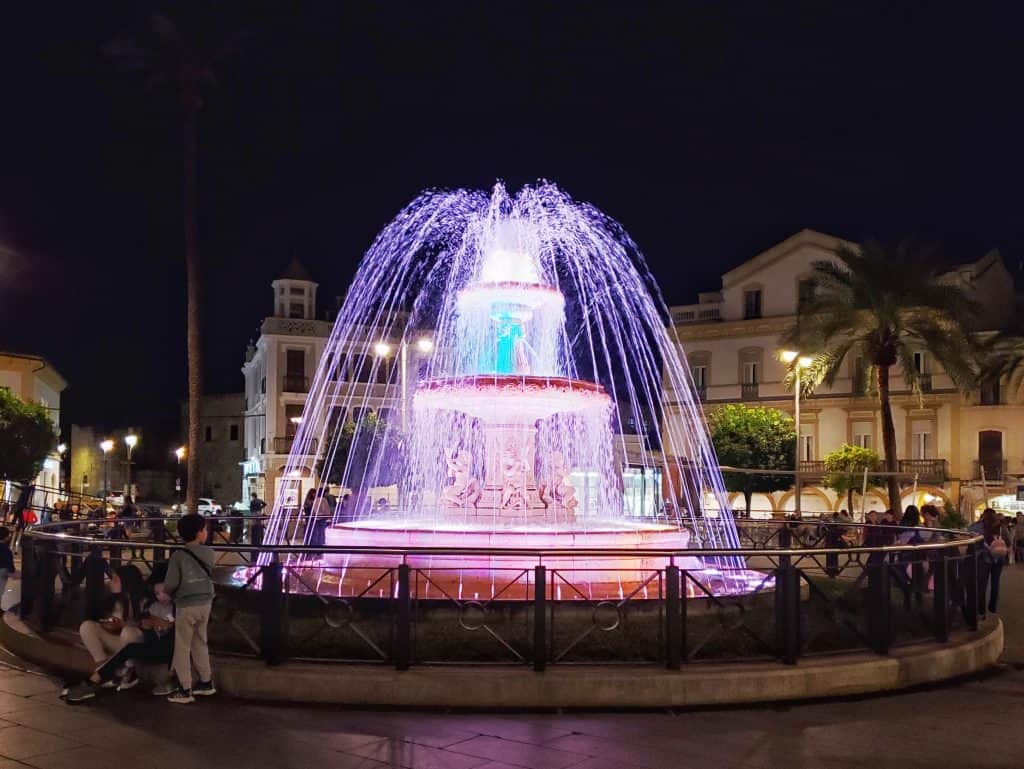
Tourist Train
We didn’t take the happy little tourist train around town since we’d already walked everywhere but my parents did when they were in town earlier this year. They thoroughly enjoyed it. It can be found in front of the theatre/amphitheatre complex and costs 4.50 for adults and 2.50 for kids for the thirty minute ride around town.
Mérida the details
Where to stay – we stayed in an Airbnb that was delightfully central. My parents stayed in the parador and have been raving ever since about how lovely it was.
Where to eat – Obviously I can’t give a full rundown on the city’s restaurant options but we very much enjoyed the meals we ate.
A de Arco – good Spanish tapas
Sawadi – best Thai food we’ve had in a very long time
Columnata – decent late night desserts and wine
Tabula Calda –my parents haven’t stopped talking about their meal here and were disappointed we didn’t go.
Where to park – there is limited street parking available but there are numerous designated car parks.
What to do near Mérida
My next trip up that way will include Zafra and Cáceres. If you’re travelling around then I hope you’ll make it over to Ronda. The province of Cádiz is positively full of gorgeous places to visit including Gibraltar sitting right on the edge, as is Huelva, home to my favourite small town, Aracena.
Suggested reading materials
 Lonely Planet Spain 13 (Tra...Shop on Amazon
Lonely Planet Spain 13 (Tra...Shop on Amazon  History of Spain: A Captiva...Shop on Amazon
History of Spain: A Captiva...Shop on Amazon
If you have found this article interesting or useful there are three things you could do: share on social media, comment below, or donate to help me keep my blog going. Which ever you pick, thank you!
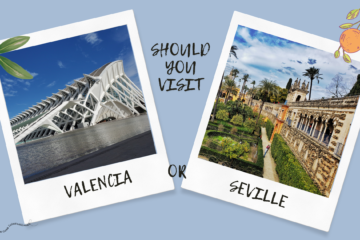
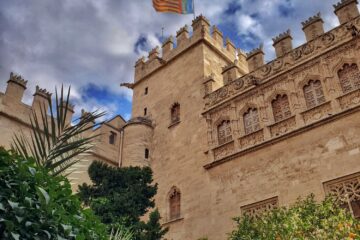
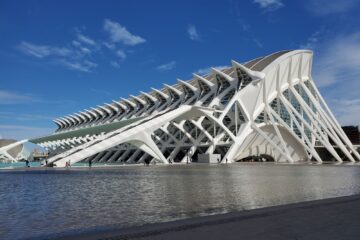
2 Comments
Rhea Williams · 09/11/2022 at 3:35 am
Thank you for this. You did all the bits we were too tired to do, after a day of walking around. Great to read about everything. Thank you.
Cassie · 09/11/2022 at 3:40 am
pleasure – thanks for reading!